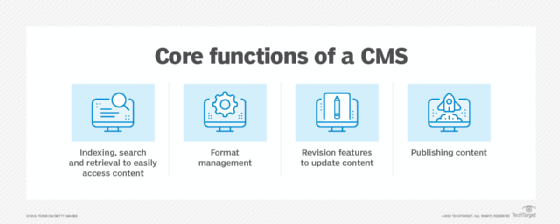
Getty Images
LMS vs. CMS: What's the difference?
A CMS can fulfill general content publishing, editing and storage needs, while an LMS is better suited to a more specific HR and employee-oriented use case.
As organizations create endless amounts of digital content, they need tools that support all their documents and media.
Two common platforms to help businesses handle their content are learning management systems (LMSes) and content management systems (CMSes). These tools offer ways to store, manage, use and share content, but they serve specific use cases that organizations should consider before adopting one or the other.
Organizations should learn the key differences between the platforms to decide between an LMS vs. CMS.
What is an LMS?
A learning management system can help create, manage and store content for various learning processes. LMSes are frequently used in higher education for instructors to share content and assignments with students and vice versa. However, businesses and other organizations can use an LMS to onboard and train employees.
LMSes can help with knowledge management, a facet of content management that focuses on an organization's internal information, including training resources and employee data. These tools can help organizations monitor users' learning, easily update training modules and make training processes more accessible to employees.
Major LMS vendors include Paylocity, TalentLMS, SAP and Adobe.

What is a CMS?
A content management system enables organizations to store, manage, maintain, publish and create content for a website without requiring users to have prior HTML knowledge or coding experience. Organizations primarily use CMSes for website content, but they also help store standard documents and records as a digital database. Additionally, marketing teams often use a CMS for content marketing.
CMSes include features to improve search functionality, support document versioning, create and publish templates, and scan and store legacy documents. These systems can scale and update easily, so organizations can embed them into employees' workflows and simplify the content management process across the business.
Major CMS vendors include WordPress, HubSpot, Wix and Sitecore.

3 main differences between LMS and CMS
LMSes and CMSes are similar platforms, as they both enable users to store and manage content, but they serve different purposes overall.
1. Primary use
Organizations may choose to adopt an LMS if they want to develop consistent onboarding and new-hire training programs. They can also adopt an LMS to train people on specific topics or by department, such as training for sales departments or regular cybersecurity education to ensure company data remains safe and employees remain compliant.
If an organization publishes content on websites, which is the case for most modern businesses, then it might adopt a CMS. With a CMS, users can collaborate on, publish, store and manage website content more easily.
2. Target audience
HR professionals are most likely to adopt an LMS outside of a higher education setting. Corporate LMSes primarily help onboard and train employees, which is an HR-led process. However, sales leaders and other department managers could use an LMS for department-specific training and to help employees continue professional development.
Content managers typically adopt CMSes, but anyone creating content for a company website can use the tool. Marketers, content creators, editors and other roles involved in creating content all use a CMS regularly.
3. Additional features
Because organizations use LMSes and CMSes for different purposes, they offer different features within the platforms. For example, LMSes commonly have the following:
- Reporting and analytics features to track people's progress on courses or training modules.
- Gamification capabilities to better motivate and engage users.
- Geolocation features to see where the user is and push location-specific content or offer multilingual support.
On the other hand, CMSes can include some search engine optimization capabilities, audit logs, discussion boards and the ability to integrate with other tools, like CRM systems, personalization engines and team collaboration platforms. Additionally, an organization could integrate its CMS with its LMS if it plans to create and host training and learning content.
Is an LMS or CMS right for you?
Organizations should start by pinpointing why they need the platform to decide between an LMS vs. CMS. A CMS will best suit their needs if they want to upload physical documents and store them digitally or launch an external-facing company website.
However, if an organization wants to improve its employee education and onboarding programs, it will benefit more from an LMS. Yet, if a business wanted to create learning content, it could integrate an LMS with a CMS to get the best of both platforms.






